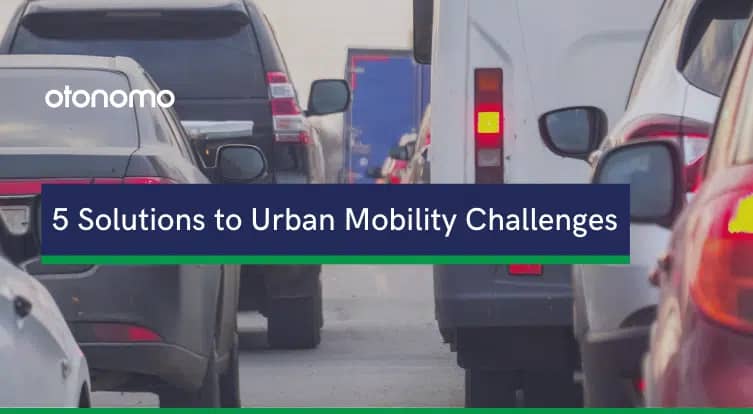Global megatrends of increasing urbanization significantly impact the already complex mobility environments, and the growing commuter population is being strained by inefficient transportation networks and congested roads on a daily basis. More cars are on the roads, poor synchronization of traffic lights, and unexpected events, such as accidents, severe weather conditions, urban construction sites and even ride hailing are the major contributors to today’s increasingly congested roads. Municipalities need to address these urban mobility challenges and worsening conditions.
During the Smart City Challenge of the US Department of Transportation (DOT), mid-sized city mayors across America were asked to identify their most pressing transportation problems. While the cities were diverse, many of the 78 applicants faced similar urban mobility challenges:
Urban Mobility Challenges
- Providing first-mile and last-mile service for transit users to connect underserved communities to jobs
- Facilitating the movement of goods into and within a city
- Reducing inefficiency in parking systems and payment
- Optimizing traffic flow on congested freeways and arterial streets
- Limiting the impacts of climate change and reducing carbon emissions
Smart Cities Use Data to Improve the Urban Landscape
Although smart cities remain in their infancy, smart mobility innovations can improve congestion and transport of people and goods in urban settings. While trying to tackle congested and inefficient roads, cities are looking for ways to enhance their collection, processing, and analysis of real-time data.
Providing first-mile and last-mile service for transit users
The majority of the local working population may spend hours getting to and from work every day, using public transportation, while private transport commuters may save time at the cost of aggravating congestion and damaging the environment. These inconvenient journeys may cause late arrivals and employee fatigue. It can even make it difficult for organizations to hire and retain employees. According to the smart city applicants, the typical job that is accessible by transit of 90 minutes or less, is only available to 27% of its metropolitan workforce.
Smart transportation solutions, such as SWAT Mobility, harness demand-responsive and ride-sharing technology for pooling passengers in shared vehicles and generating the optimal routes to pick them up and drop them off. SWAT Mobility is leveraging real-time vehicle data to optimize the pickup time, journey time and pooling rate of rides, and to provide an improved riding experience for all.
Smart urban mobility solutions generate cost savings, while increasing employee productivity and facilitating business expansion.
Facilitating the movement of goods into and within a city
Congestion wastes a massive amount of time and fuel, and creates more uncertainty for drivers and freight. Trucks stuck in urban congested traffic cost shippers an estimated $28 million annually in truck operating costs and wasted fuel, according to the US DOT smart challenge.
Leveraging multiple data sources – from demographic data to road information and traffic flows of commercial and private vehicles as well as and public transportation, the PTV Group provides intelligent traffic management and transport optimization solutions for planning and optimizing transport logistics. PTV group is incorporating real-time and historical vehicle data into its models and planning tools to provide route planning, scheduling optimization, navigation, cost calculation and arrival times prediction.
Real-time Traffic data is being used to save time and money, make roads safer, and further plan urban infrastructure.
Increase efficiency in parking systems and payments
Cruising for parking creates a moving queue of cars that typically maintain slow speeds, frequently change lanes, and suddenly brake or accelerate. It is estimated that 30 percent of urban congestion is caused by cars looking for parking.
Parking data regularly generated by passenger vehicles that are driving in cities can provide rich information for a variety of parking use cases, such as parking spot mapping, usage statistics and prediction to alleviate congestion due to cruising for parking.
Combining parking data from vehicles with mapping information can help identify available parking spots in real-time and guide drivers to open parking spaces in an urban area, while informing them about the parking type (parallel or cross) and side (left/right).
Parking apps can also increase safety by alerting when a vehicle is too close to the curb or the parking position is too far from the curb and may create a road hazard. Automated parking solutions can facilitate quicker payments and expedite parking space vacancy.
Parking and mapping data can be used to improve parking solutions in urban settings, reduce urban congestion and minimize the environmental impact of cruising for parking.
Optimizing traffic flow on congested roads
Traffic management is a strategic problem for virtually every city. Congestion is often located in and around urban areas and costs nearly EUR 100 billion, or 1 % of the EU’s GDP, annually. Some urban traffic issues occur due to rapid urban transformation and some are due to low-quality infrastructure, urban planning failures, or poor management of traffic controls. Outdated traffic signal timing, for example, causes more than 10 percent of all traffic delay on major routes in urban areas.
Waycare aggregates, synthesizes, and analyzes crowdsourced data, including vehicle data, to unlock key real-time and predictive operational insights about roads. Waycare’s machine learning algorithm, drives predictive recommendations that improve traffic flows in urban areas, predict traffic “hot spots”, accelerate emergency responses, and facilitate smarter traffic engineering.
When it comes to keeping roadways safe and traffic flowing, municipalities can tap into more data than ever before by leveraging the real-time vehicle data, generated by millions of connected cars on the road.
Vehicle data can convey an accurate picture of what’s happening on the road to improve real-time traffic flows and support intelligent and responsive operations of advanced traffic management systems.
Limiting the impact of climate change and reducing carbon emissions
Burning fossil fuels like gasoline and diesel releases carbon dioxide (CO2), a greenhouse gas, into the atmosphere. Rapid urban population growth, traffic congestion and related air pollution, as well as ageing infrastructure, put cities at the center of the carbon emission mitigation agenda. Currently, cities are responsible for 60 to 80% of all energy consumption and approximately 70% of carbon emissions in the world. Urban mobility accounts for 40% of all CO2 emissions of road transport.
Cities shifting to low emission transport options – such as walking, cycling, public transport and zero emission vehicles – reap economic rewards and deliver significant quality of life benefits for their citizens. Cities that take the lead in adapting to climate change, install electric vehicle infrastructure, convert public fleets and buses to electric vehicles, and incentivize shared-use mobility options.
Efficient Electric Vehicle (EV) charging is a critical factor in increasing EV adoption. EV vehicle data can make it simple and fast for EV service providers to improve charging infrastructure and experience, making EV ownership more convenient for drivers.
Employing historical vehicle data, EV service providers can identify charging patterns, select the ideal locations for new charging sites and optimize charging loads across a facility. Personal apps can provide EV drivers with tools to plan their travels, while taking into account all of their charging needs.
Vehicle data plays an instrumental role in reducing range anxiety and making electric vehicles a viable option for reducing carbon emissions.
Tap into vehicle data to relieve urban mobility challenges
Vehicle data supports a safer and more efficient global urbanization by powering smarter apps and services that reduce congestion, mitigate traffic accidents, and improve drivers and residents’ quality of life.
Interested in learning more about how vehicle data can be used by smart cities? Speak to one of our data experts.
Read about vehicle data in action. Download Otonomo’s Data Driven Driving Report









